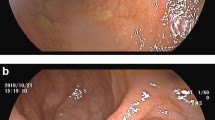Abstract
Background
Double-balloon enteroscopy (DBE) is theoretically useful in Crohn’s disease (CD) since it is potentially able to investigate the whole small intestine, but sparse data are available.
Aim
To assess the feasibility, safety, and diagnostic yield of DBE in CD.
Methods
The study was conducted in a tertiary care centre for inflammatory bowel disease. Thirty-seven patients with CD (18/19 male/female, mean age 42 years, range 13–77 years) were considered. Thirty-two DBEs from the oral approach and 18 from the anal (in 6 patients from both ways with a complete exploration in 4, 10.8%) were performed. Indications were: first diagnosis/staging in 16 cases, diagnosis of stenosis in 7, obscure bleeding in 10, suspected neoplasia in 2, and postsurgical evaluation in 2. One hundred and thirty-three other procedures (3.7 per patient) were performed with the same indication.
Results
Insertion depth from the oral route was 266.5 ± 100 cm and from the anal route 72.5 ± 60 cm. Ileocecal valve was passed in 8/13 patients, but in 4 DBE explored less than 50 cm of ileum. Diagnostic yield was 59.4% but changed according to indication (40% in obscure bleeding, 100% in case of strictures) and was higher when DBE was conducted on the basis of previous investigations (77.8% versus 40%, p = 0.037).
Conclusion
DBE is a feasible, useful, but technically demanding method in CD. Definition of the proper introduction route by means of previous investigations is associated with a higher efficacy of DBE.

Similar content being viewed by others
References
Mekhjian HS, Switz DM, Melnyk CS et al (1979) Clinical features and natural history of Crohn’s disease. Gastroenterology 77:898–906
Steinhardt HJ, Loeschke K, Kasper H et al (1985) European Cooperative Crohn’s Disease Study [ECCDS]: clinical features and natural history. Digestion 31:97–108
Fefferman DS, Farrell RJ (2005) Endoscopy in inflammatory bowel disease: indications, surveillance, and use in clinical practice. Clin Gastroenterol Hepatol 3:11–24
Hommes DW, Van Deveneter SJH (2004) Endoscopy in inflammatory bowel diseases. Gastroenterology 126:1561–1573
Eliakim R, Fischer D, Suissa A et al (2003) Wireless capsule video endoscopy is a superior diagnostic tool in comparison to barium follow-through and computerized tomography in patients with suspected Crohn’s disease. Eur J Gastroenterol Hepatol 15:363–367
Buchman AL, Miller FH, Wallin A et al (2004) Videocapsule endoscopy versus barium contrast studies for the diagnosis of Crohn’s disease recurrence involving the small intestine. Am J Gastroenterol 99:2171–2177
Triester SL, Leighton JA, Leontiadis GI et al (2006) A meta-analysis of the yield of capsule endoscopy compared to other diagnostic modalities in patients with non-stricturing small bowel Crohn’s disease. Am J Gastroenterol 101:954–964
Cave D, Legnani P, de Franchis R et al (2005) ICCE consensus for capsule retention. Endoscopy 37:1065–1067
Anonymous (2006) ASGE guideline: endoscopy in the diagnosis and treatment of inflammatory bowel disease. Gastrointest Endosc 63:559–565
Chutkan RK, Scherl E, Waye JD (2002) Colonoscopy in inflammatory bowel disease. Gastrointest Endosc Clin North Am 12:463–483
Minderhoud IM, Samsom M, Oldenburg B (2007) What predicts mucosal inflammation in Crohn’s disease patients? Inflamm Bowel Dis 13:1567–1572
Yamamoto H, Kita H, Sunada K et al (2004) Clinical outcomes of double-balloon endoscopy for the diagnosis and treatment of small-intestinal diseases. Clin Gastroenterol Hepatol 2:1010–1016
Pennazio M (2007) Crohn’s disease: diagnostic and therapeutic potential of modern small-bowel endoscopy. Gastrointest Endosc 66(Suppl):91–93
Oshitani N, Yukawa T, Yamagami H et al (2006) Evaluation of deep small bowel involvement by double-balloon enteroscopy in Crohn’s disease. Am J Gastroenterol 101:1484–1489
Seiderer J, Herrmann K, Diepolder H et al (2007) Double-balloon enteroscopy versus magnetic resonance enteroclysis in diagnosing suspected small-bowel Crohn’s disease: results of a pilot study. Scand J Gastroenterol 42:1376–1385
May A, Nachbar L, Schneider M et al (2005) Push-and-pull enteroscopy using the double-balloon technique: method of assessing depth of insertion and training of the enteroscopy technique using the Erlangen endo-trainer. Endoscopy 37:66–70
D’haens G, Van Deventer S, Van Hogezand R et al (1999) Endoscopic and histological healing with infliximab anti-tumor necrosis factor antibodies in Crohn’s disease: a European multicenter trial. Gastroenterology 116:1029–1034
Hanauer SB, Feagan BG, Lichtenstein GR et al (2002) Maintenance infliximab for Crohn’s disease: the ACCENT I randomised trial. Lancet 359:1541–1549
Ell C, May A, Nachbar L et al (2005) Push-and-pull enteroscopy in the small bowel using the double-balloon technique: results of a prospective European multicenter study. Endoscopy 37:613–616
DiCaro S, May A, Heine DGN et al (2005) The European experience with double-balloon enteroscopy: indications, methodology, safety, and clinical impact. Gastrointest Endosc 62:545–550
Chen X, Ran ZH, Tong JL (2007) A meta-analysis of the yield of capsule endoscopy compared to double-balloon enteroscopy in patients with small bowel diseases. World J Gastroenterol 28(13): 4327-4378
Pennazio M, Eisen G, Goldfarb N (2005) ICCE consensus for obscure gastrointestinal bleeding. Endoscopy 37:1046–1050
Voderholzer WA (2006) The role of PillCam endoscopy in Crohn’s disease: the European experience. Gastrointest Endosc Clin North Am 16:287–297
Author information
Authors and Affiliations
Corresponding author
Rights and permissions
About this article
Cite this article
Manes, G., Imbesi, V., Ardizzone, S. et al. Use of double-balloon enteroscopy in the management of patients with Crohn’s disease: feasibility and diagnostic yield in a high-volume centre for inflammatory bowel disease. Surg Endosc 23, 2790–2795 (2009). https://doi.org/10.1007/s00464-009-0518-z
Received:
Revised:
Accepted:
Published:
Issue Date:
DOI: https://doi.org/10.1007/s00464-009-0518-z




